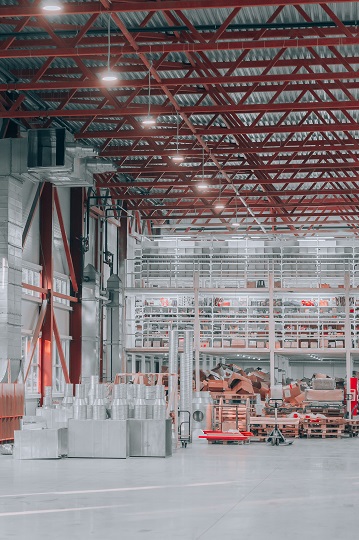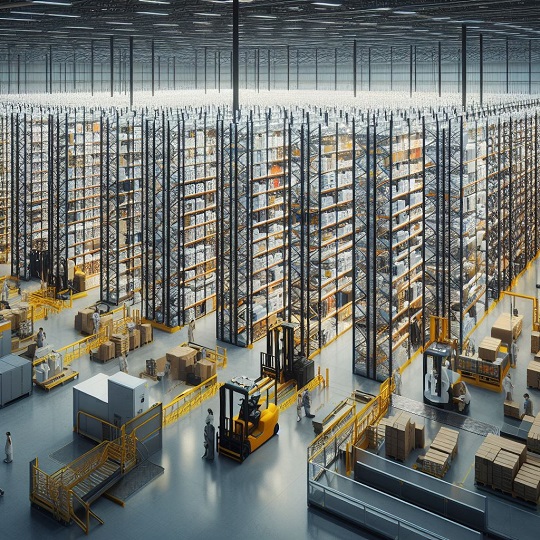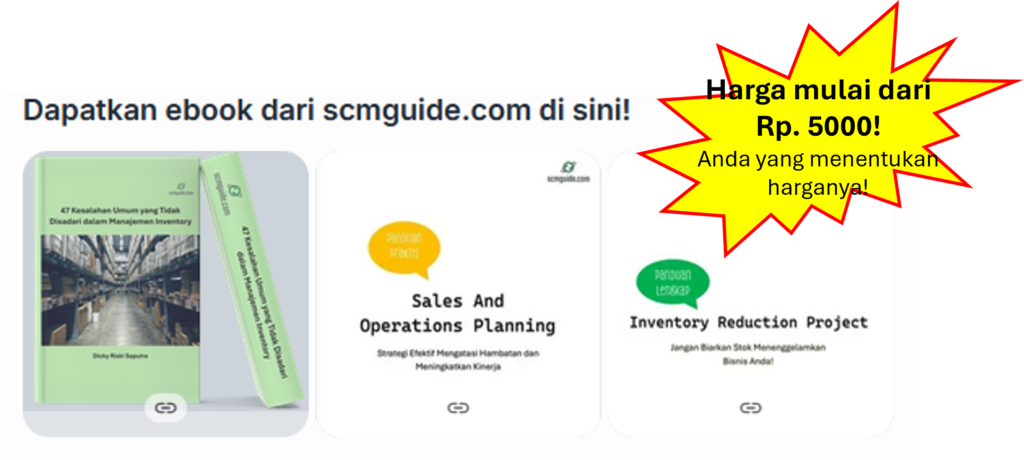Warehouse management is vital for businesses that handle physical products. A common issue faced by warehouse managers is finding the right balance between space and inventory levels.
When the inventory fills up the aisles, it disrupts operations, causing inefficiencies and potential losses. In such situations, managers have two main options: they can either expand the warehouse space or reduce the amount of inventory.
Both options have their pros and cons, which can make the decision tricky.
Let’s take a closer look at the advantages and disadvantages of each choice and discuss strategies for making the best decision.
Before we go further into this topic, don’t forget to follow my LinkedIn account. You’ll get more helpful insights on supply chain management there.
Table of Contents
Option 1: Increase Warehouse Area
Positives
Expanded Capacity
Increasing warehouse space allows businesses to store more inventory, addressing the need for scalability and accommodating growth in demand or product variety.
With additional space, businesses can avoid overcrowding, which can lead to logistical challenges and operational issues.
This extra room helps manage fluctuations in inventory levels, whether due to seasonal changes or business expansion plans. This flexibility ensures the warehouse can support the company’s needs over time.
Furthermore, expanding warehouse space improves operational efficiency by organizing inventory better. With more space, products can be arranged logically, making workflows smoother and reducing the time needed for order fulfillment.
This efficiency extends to employee productivity, as they can navigate the warehouse more easily, reducing errors and improving safety.
Overall, increasing warehouse space not only allows for more inventory but also enhances operations, ensuring businesses can meet customer demands efficiently.
Improved Workflow
Increasing warehouse space allows workers to move freely, boosting productivity and safety. With more room to navigate between shelves and aisles, workers can perform tasks like picking, packing, and restocking more efficiently.
This improved mobility speeds up work and enhances overall productivity levels.

Additionally, reduced congestion in the warehouse minimizes bottlenecks and delays, ensuring smoother workflows and timely order fulfillment.
Moreover, having more space creates a safer environment for employees. With fewer obstacles, workers are less likely to encounter hazards or trip over cluttered areas, reducing the risk of accidents and injuries.
Better visibility and accessibility enable employees to focus on their tasks, improving job satisfaction and morale.
Prioritizing safety through adequate space demonstrates a commitment to employee well-being while avoiding potential costs and disruptions associated with workplace accidents.
In summary, increased warehouse space not only boosts productivity but also fosters a safer and more efficient working environment for all warehouse personnel.
Flexibility
Additional warehouse space offers businesses valuable flexibility to adapt to changing needs and market demands. With more space, businesses can rearrange warehouse layouts to optimize efficiency and accommodate shifts in inventory management strategies.
This flexibility allows for leaner processes that boost productivity and reduce waste.
Moreover, the extra space allows businesses to experiment with innovative storage solutions and automation technologies, enhancing operational efficiency and scalability to stay competitive.
Furthermore, the surplus space enables businesses to respond effectively to shifting market demands and consumer preferences. With room to stockpile inventory during low-demand periods and quickly scale up during surges, businesses can seize opportunities without storage constraints.
Additionally, the ability to store a diverse range of products in response to market trends enhances resilience and competitiveness, ensuring businesses can meet customer expectations and maintain relevance over time.
Ultimately, additional warehouse space empowers businesses to adapt, innovate, and thrive in a dynamic business landscape.
You might also like:
- 6 Tips to Manage Inventory with Expiry Dates and Minimize Losses
- 7 Ways to Manage Material Specification Changes in the Warehouse to Ensure Smooth Transitions
Negatives
High Costs
Expanding warehouse facilities requires significant upfront investments in construction, lease agreements, permits, and infrastructure upgrades. Construction costs, including materials, labor, and equipment rentals, can be substantial, especially for extensive building projects. Negotiating suitable lease agreements for expanded space may result in higher rental rates or longer lease terms.

Additionally, obtaining necessary permits from local authorities adds to expenses and project timelines. Infrastructure upgrades like utilities and security systems further contribute to initial investment costs.
Moreover, ongoing operational expenses must be considered beyond construction costs. These include utilities, property taxes, insurance premiums, maintenance, and staffing expenses. Changes to logistics and transportation may also incur additional costs due to adjustments in distribution networks or fulfillment processes.
While the initial investment for warehouse expansion can be significant, businesses must carefully weigh long-term benefits such as increased storage capacity and operational efficiency.
Effective financial planning and risk management strategies are crucial to navigate the financial challenges and ensure the project’s success and sustainability in the long run.
Time Consuming
Expanding warehouse facilities through construction or relocation can be time-consuming and challenging for businesses. The construction phase involves detailed planning, material procurement, contractor hiring, and adherence to building codes.
Delays in any of these aspects can extend the construction timeline and increase costs.
Coordinating construction activities while maintaining warehouse operations requires careful planning to minimize disruptions, such as temporary closures or restricted access to certain areas.
Unforeseen challenges like adverse weather or supply chain disruptions can further prolong construction, adding to frustrations.
Similarly, the relocation process for expanding warehouse facilities is also time-consuming and disruptive. Moving inventory, equipment, and personnel requires meticulous planning to ensure a smooth transition.
Disassembling and reassembling warehouse equipment is labor-intensive and may cause downtime.
Coordinating relocation timing with ongoing business activities is crucial to minimize disruptions to customer service and order fulfillment. Updating addresses, permits, and licenses adds to administrative burdens and may delay realizing benefits from expanded facilities.
Overall, these time-consuming processes pose significant challenges, requiring careful planning and execution to mitigate disruptions and ensure success.
Maintenance Overhead
Expanding warehouse facilities to accommodate larger inventory volumes results in increased operational expenses over time. One significant cost factor is additional maintenance needs.
With more space to maintain, including flooring, lighting, HVAC systems, and equipment, businesses face higher upkeep and repair costs.

As the warehouse ages, maintenance expenses tend to rise, requiring investments in upgrades and renovations for optimal functionality and safety. These ongoing expenses strain the operational budget, impacting profitability in the long run.
Moreover, expanding warehouses require increased spending on security measures to protect inventory and assets. Larger spaces pose more security challenges, necessitating comprehensive security systems such as surveillance cameras and access control.
Investments in advanced security technologies are essential to address emerging threats like cyberattacks.
Additionally, larger spaces incur higher utility costs, including electricity and heating/cooling expenses. Implementing energy-efficient practices becomes crucial to manage utility expenses effectively.
While expanding warehouses offers growth opportunities, businesses must carefully manage operational costs to ensure long-term financial viability.
You might also like:
- 4 Criteria for Suitable Containers to Ensure Food Safety in Shipping
- How to Create Standard Container Vanning Layouts
Option 2: Reduce Inventory Levels
Positives
Cost Savings
Lowering inventory levels leads to immediate financial savings by reducing various holding costs associated with excess inventory. One significant saving comes from decreased storage fees, as fewer products require less space in the warehouse, potentially lowering rental or lease expenses.
Moreover, lower inventory levels result in reduced insurance premiums, as coverage is based on inventory value, mitigating risks of loss or damage.
Decreased inventory levels also lower depreciation expenses, contributing to immediate financial savings and improving inventory management efficiency.
Furthermore, minimizing excess inventory streamlines supply chain operations, reducing carrying costs and freeing up capital for other business investments.
Optimized inventory levels improve cash flow, enabling businesses to allocate resources more efficiently and pursue growth opportunities.
Lower inventory levels enhance turnover rates, allowing for quicker responses to market demand changes and reducing the risk of obsolete inventory and associated disposal expenses.
Overall, by reducing holding costs and improving operational efficiency, lower inventory levels lead to sustainable cost savings and improved profitability in the long term.
Lean Operations
Minimizing excess inventory helps businesses streamline processes and allocate resources more efficiently, boosting operational efficiency. By keeping inventory at optimal levels, businesses reduce time and effort spent on managing excess goods, allowing smoother workflows focused on essential tasks like order fulfillment and quality control.

Additionally, lower inventory levels decrease the risk of overproduction and waste, improving profitability by avoiding unnecessary write-offs or markdowns.
Furthermore, minimizing excess inventory enables better resource allocation. Rather than tying up capital in surplus inventory, businesses can invest in areas like product innovation, marketing, or employee training, enhancing agility and competitiveness.
Leaner inventory levels also improve supply chain management, leading to more efficient procurement, reduced lead times, and lower carrying costs, ultimately driving efficiency and profitability.
Overall, minimizing excess inventory streamlines processes, reduces waste, and optimizes resource allocation, enhancing business efficiency and competitiveness.
Increased Agility
Maintaining lean inventory levels gives businesses the flexibility to respond quickly to market changes, customer needs, and supply chain issues.
With lean practices, businesses can adjust inventory in real-time, ensuring they have the right amount of stock without excess. This agility allows them to seize opportunities and meet demand efficiently, avoiding stockouts or excess inventory costs.
Furthermore, lean inventory management boosts resilience against supply chain disruptions. By operating with less inventory, businesses reduce risks of obsolescence or storage costs. They can also manage disruptions like delays in deliveries more effectively, ensuring continuity in operations.
Overall, maintaining lean inventory levels helps businesses navigate uncertainties and challenges, setting them up for long-term success in a dynamic business environment.
Negatives
Stockouts Risk
Overly aggressive inventory reduction strategies can pose significant risks to businesses, mainly by increasing the chances of stockouts.
When inventory levels are cut too drastically, businesses may struggle to meet customer demand, leading to stockouts where products become unavailable.
This can result in lost sales and damage to the business’s reputation as customers may turn to competitors.
Repeat stockouts can lead to customer dissatisfaction, reducing customer loyalty and harming the business’s market standing.

Moreover, aggressive inventory reduction strategies can strain relationships with suppliers. Businesses may struggle to fulfill obligations or meet minimum order requirements, causing delays or higher prices for goods. Suppliers may prioritize other customers with more stable inventory levels, worsening supply chain disruptions.
Ultimately, strained supplier relationships can hinder the business’s ability to procure materials, worsening the risk of stockouts and impacting customer satisfaction and revenue.
Supplier Relationships
Cutting inventory levels too drastically can strain relationships with suppliers in several ways, mainly impacting lead times and pricing negotiations. Suppliers need consistent orders to plan production and allocate resources efficiently.
Aggressive inventory cuts can disrupt these plans, leading to longer lead times as suppliers adjust to changing demands. Reduced orders may also weaken businesses’ bargaining power, resulting in higher procurement costs and lower profit margins.
Moreover, drastic cuts can jeopardize supply chain reliability. Suppliers may see businesses with inconsistent orders as unreliable partners, leading to strained relationships and decreased trust. This can result in suppliers prioritizing other customers or reducing commitment to fulfilling orders, worsening supply chain disruptions.
Additionally, businesses relying heavily on just-in-time inventory management may face vulnerability to supply chain shocks.
Ultimately, strained supplier relationships can cause production delays, increased costs, and reduced competitiveness.
Limited Buffer
Reduced inventory levels provide businesses with flexibility and agility to navigate challenges efficiently. Operating with leaner inventories conserves capital and optimizes resource allocation, allowing businesses to respond quickly to changes in demand or market conditions.
During sudden spikes in demand, lean businesses can adjust production or procurement strategies promptly without excess inventory.
Similarly, during supplier disruptions, they can rely on existing stock or find alternative suppliers.
However, overly lean inventories may leave businesses vulnerable to unexpected disruptions. In such cases, businesses may struggle to replenish stock quickly, leading to potential stockouts or lost sales.

Without adequate contingency plans, supply chain disruptions can worsen, impacting customer satisfaction and damaging relationships.
Therefore, while lean inventory practices offer efficiency and cost savings, businesses must balance agility with maintaining sufficient inventory buffers to mitigate risks effectively.
You might also like:
- 10 Strategies to Overcome Data Processing Challenges for Supply Chain Teams Lacking Expertise
- 10 Steps to Prevent Warehouse Theft of Goods
How to Decide?
Analyze Data
Analyzing historical sales data, demand forecasts, and inventory turnover rates is vital for businesses to find the right inventory levels. Historical sales data reveals buying patterns, seasonal trends, and customer preferences, helping predict future sales accurately. This data forms the basis for inventory planning, allowing businesses to adjust stock levels to meet demand without overstocking or running out of products.
Furthermore, inventory turnover rates gauge inventory management efficiency. A higher turnover rate means goods sell quickly, reducing storage costs.
By leveraging these metrics, businesses can develop data-driven inventory strategies that balance customer demands with operational efficiency, ensuring optimal stock levels while maximizing profitability.
Evaluate Costs
Businesses must conduct a cost-benefit analysis to decide between increasing warehouse space or reducing inventory levels. They should estimate expenses for expanding warehouse space, including construction, leases, permits, and upgrades, to weigh against potential benefits.
Ongoing costs like maintenance and utilities must also be considered to assess financial feasibility.
On the other hand, businesses should calculate savings from inventory reduction, including lower storage fees, insurance, and depreciation expenses.
Optimizing inventory levels can improve efficiency, reduce waste, and enhance resource allocation, leading to additional savings.
By analyzing both the expenses of expanding warehouse space and the benefits of inventory reduction, businesses can make informed decisions to maximize profitability and efficiency.
Consider Long-Term Strategy
Aligning warehouse decisions with the company’s long-term goals, growth projections, and market dynamics is crucial for sustainable operations. By considering overarching objectives and growth strategies, businesses can make informed decisions on warehouse expansion or inventory management.
For instance, if aiming to increase market share, investing in warehouse expansion may be necessary.

Similarly, for improving efficiency and reducing costs, focusing on lean inventory practices may be more suitable. This alignment ensures infrastructure investments support strategic vision and contribute to sustained growth.
Moreover, incorporating growth projections and market dynamics allows businesses to adapt to industry trends and consumer preferences. Analyzing demand forecasts and trends helps anticipate inventory requirements and adjust warehouse operations accordingly.
For instance, increasing warehouse space or adjusting inventory levels to meet rising demand. Conversely, businesses can optimize inventory levels to mitigate risks during downturns or shifts in consumer behavior.
By aligning warehouse decisions with market dynamics, businesses position themselves for long-term success and resilience in a competitive landscape.
Implement Continuous Improvement
Adopting lean principles, investing in inventory management technologies, and regularly optimizing warehouse processes are vital for maintaining efficiency. Lean principles focus on eliminating waste and improving processes to boost productivity and cut costs.
This involves practices like just-in-time inventory management, which reduces excess stock and boosts responsiveness to customer needs. Employees are encouraged to participate in problem-solving and innovation, fostering a culture of continuous improvement.
Investing in inventory management technologies automates tasks like tracking inventory and fulfilling orders. Barcode scanners and warehouse management software provide real-time visibility into inventory levels, aiding data-driven decision-making and reducing errors. These technologies enhance productivity and customer satisfaction, helping businesses stay competitive.
Regularly reviewing and optimizing warehouse processes ensures operations remain efficient and adaptable.
Assessing KPIs, identifying areas for improvement, and implementing enhancements keeps operations aligned with business goals. This may include redesigning workflows or adopting new technologies to streamline processes and reduce bottlenecks.
By prioritizing continuous improvement, businesses maintain competitiveness and drive long-term success in warehouse management.
Conclusion
Balancing warehouse space and inventory levels is key for efficient supply chain management.
Whether to increase warehouse size or cut inventory depends on factors like cost and long-term strategy.
By using data and continuous improvement, businesses can optimize operations and grow sustainably in a competitive market.
I hope you find it helpful!
Please share this article with your colleagues so they can also benefit. For more insights on supply chain management, follow my LinkedIn account. You’re free to use all articles on this blog for any purpose, even for commercial use, without needing to give credit.

 by
by 

